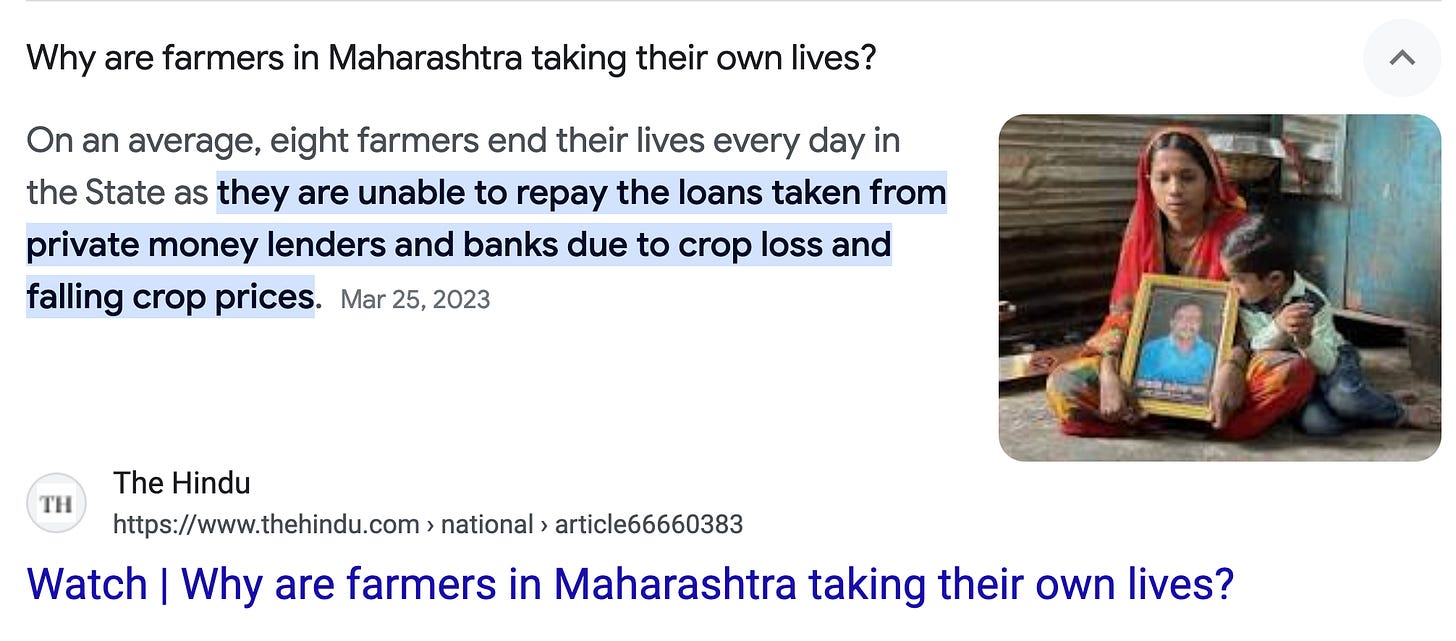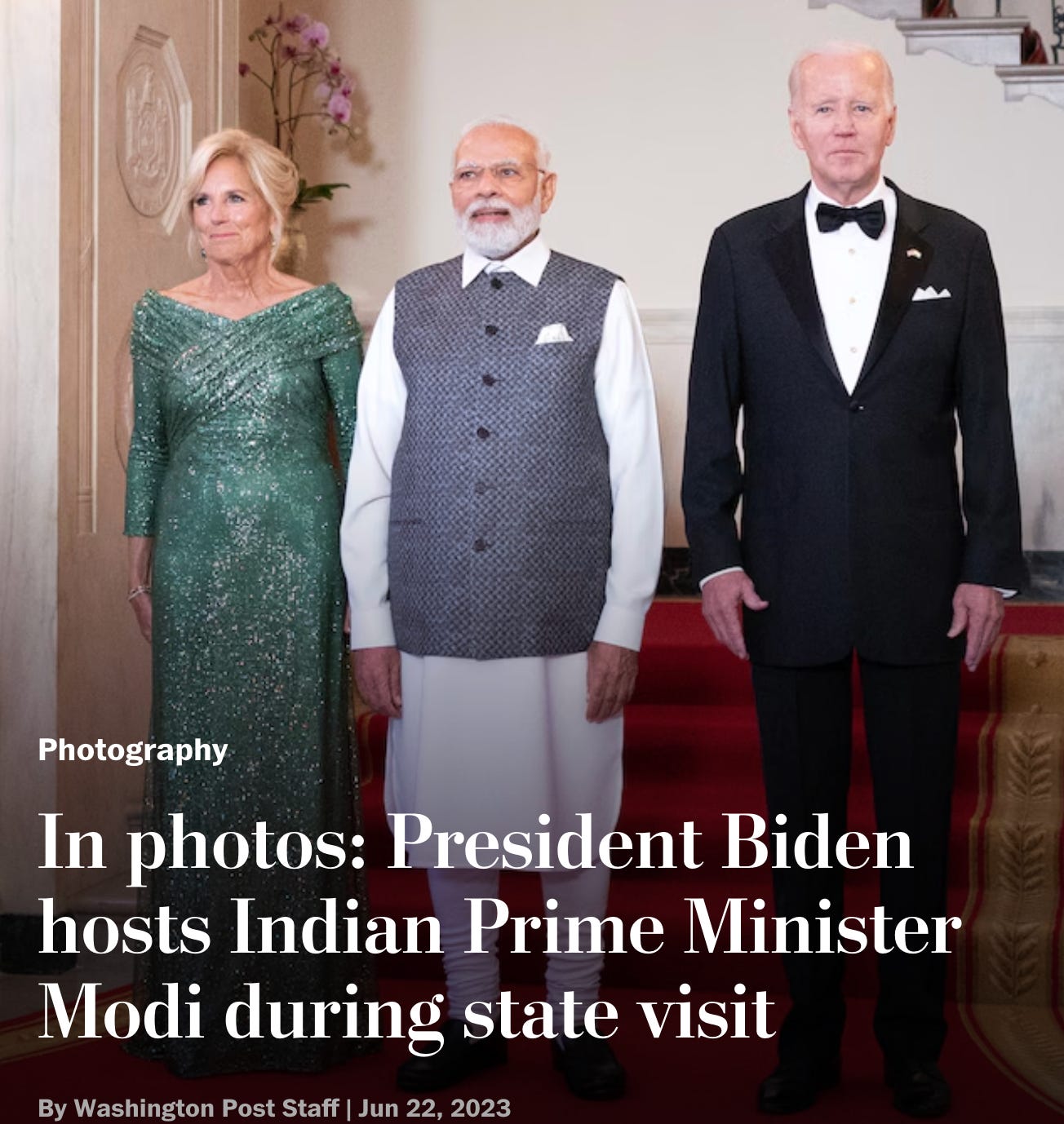In India 30 Farmers Per Day Commit Suicide Due to Onerous Debt to Rich People Like Mr. Ambani Who Lives In His 27-Story Mansion by, As the NYT Reports, "the Grace of God"
Methinks such gross inequality is actually by the grace of mortals such as India's Modi, Russia's Putin and the USA's Biden as well as others in that class
This 27-story mansion is the home of India’s richest man, the wedding of whose son is the focus of this New York Times article that includes a photo of the mansion and other quotations and some photos below.
I’m not sure, but the word on the street is that very few other people in India live in such large mansions. (Please feel free to do your own research to check up on this, however.)
One of the consequences of a society having some rich and some poor—i.e., class inequality—is that in order for the rich to remain in power with their wealth and privilege, they must treat the have-nots like dirt, as I discuss in concrete detail here. Otherwise the have-nots would make a far more equal and democratic society and the rich would no longer be the privileged and all-powerful ruling class that they are.
In India farmers are driven to suicide by class inequality:
Here’s an extract from a CNN article about India’s epidemic of farmer suicides:
Editor’s Note: Gunisha Kaur is a physician and human rights researcher. She is an assistant professor at Weill Cornell Medicine, director of the Human Rights Impact Lab, and a Stephen M. Kellen Term Member at the Council on Foreign Relations. The views expressed in this commentary are her own. View more opinion on CNN.
CNN —
Gazing across the pristine fields in the district of Sangrur in northern India, there was little indication families here were struggling. A nearby canal brought water to the wheat and rice crops that were the life source of the village’s farmers.
Typical for India, the edges of the canal were littered with empty plastic bags, soda cans, and dark orange pesticide containers that swirled together in a corner where the water met a bridge.
But alongside the discarded trash floated something else: a bloated body. It was the third body that had been sighted that day, locals told us.
I’ve encountered many devastating scenes like this, since I first started visiting farming families across the state of Punjab almost a decade ago. I go as part of a medical exchange program where American physicians learn how biopsychosocial factors – such as government policies, the environment or economics – impact health globally. Our group also partners with the local Baba Nanak Education Society, to gain a grassroots perspective.
In some cases, locals retrieve these bodies and return them to their families. Often, they are not recognizable and left to decompose in the river. By village consensus, the cause of death in this case was suicide. Though I’m not sure the body was ever identified.
During these visits, we speak to families affected by the epidemic of farmer suicides. Those left behind – parents, wives and children – share their immense grief in the wake of a death. They describe debt passed from one deceased son to another, resulting in multiple suicides in one family.
The families tell us that children, particularly girls, are pulled out of school because they can no longer afford the cost of education. Young girls show us their carefully guarded treasure of dowry goods, woven with their own hands, to decrease the ultimate financial burden on their families.
The situation for India’s more than 260 million agricultural workers is dire. Nearly 30 people in the farming sector die by suicide daily, according to the most recent figures available, typically due to overwhelming debt. Indeed in 2020, more than 10,000 people in the agricultural sector ended their own lives, according to government data.
India’s economic backbone – its farmers and their families – is in collapse. They face crushing pressures: insurmountable debt, environmental degradation, and extreme rates of cancer linked to exposure to pesticides.
More than just the farmers suffer from the class inequality. “In India, the wealth of 16 people is equal to the wealth of 600 million people….One India boasts billionaires and brainiacs, nuclear bombs, tech and democracy. The other is inhabited by people like Amina. In that India, almost 75% still lives in villages and leads a hardscrabble life of labor; only 11% owns a refrigerator; 35% cannot read and write.”
Seeing the new India through the eyes of an invisible woman
By Moni Basu, CNN
Video by Nick Scott and Jordan Mendys, CNNKolkata, India (CNN) — Not far from the place I once called home stands one of India's glitziest shopping malls. By day, the massive building dwarfs every structure around it. At night, a dizzying display of lights cruelly exposes the surrounding shops and houses grown green, brown and weary from pollution and rain.
Inside this shining behemoth called Quest, Kolkatans with fat pocketbooks spend their rupees on luxury foreign brands such as Gucci and eat at Michelin-star restaurants.
Outside, life's cadences remain much the same for people like my friend Amina.
She lives in a slum in the shadow of Quest.
She is part of a faceless, often-cited statistic: About 60% of India's nearly 1.3 billion people live on less than $3.10 a day, the World Bank's median poverty line. And 21%, or more than 250 million people, survive on less than $2 a day.
Like other middle-class Indians, I grew up knowing little about poor people's lives. We moved in separate worlds, which, in my mind, only grew further apart as India lurched ahead as a global economic power. The rich got richer; the poor mostly stayed poor. And the gap widened.
Today, the richest 10% in India controls 80% of the nation's wealth, according to a 2017 report published by Oxfam, an international confederation of agencies fighting poverty. And the top 1% owns 58% of India's wealth. (By comparison, the richest 1% in the United States owns 37% of the wealth.)
Another way to look at it: In India, the wealth of 16 people is equal to the wealth of 600 million people.
Those startling numbers about my homeland make me think of it as almost schizophrenic.
One India boasts billionaires and brainiacs, nuclear bombs, tech and democracy. The other is inhabited by people like Amina. In that India, almost 75% still lives in villages and leads a hardscrabble life of labor; only 11% owns a refrigerator; 35% cannot read and write.
Here is the son of the billionaire with his bride:
And here is the proud billionaire father of the groom:
The New York Times article reports on the obscene amount of money the billionaire father of the groom spent on the wedding this way:
The younger son of Mukesh Ambani, India’s richest man, is set to wed his fiancée in Mumbai on Friday, the finale of a monthslong extravaganza that signaled the arrival of the unapologetic Indian billionaire on the global stage — and introduced the world to the country’s Gilded Age.
For much of the year, the festivities surrounding the nuptials of Anant Ambani and Radhika Merchant, the daughter of a fellow business tycoon, have grabbed eyeballs for their lavish displays of wealth. Millions have been spent on diamonds and emeralds the size of credit cards, on haute couture saris, on wedding invitations made of silver and gold.
Billionaire businessmen, Bollywood stars, models and politicians were among the more than 1,200 guests at a pre-wedding bash in March. Bill Gates stopped by. Rihanna performed. In May, the bride and groom-to-be threw a four-day party on a luxury cruise ship in the Mediterranean; Ms. Merchant told Vogue India they couldn’t find a land venue big enough to host all their guests.
The NYT also throws in this “Don’t worry, there’s nothing wrong about this, nothing to see, just keep moving” gem:
“Based on the level of the Ambanis’ wealth, the wedding is perfect,” said Mani Mohan Parmar, a 64-year-old resident from Mumbai.
“Even the common man here in India spends more than his capacity on a wedding,” Ms. Parmar said. “So it’s nothing too much if we talk about Ambani. He has so much money due to God’s grace, so why shouldn’t he spend it by his choice?”
See? Enormous wealth in the hands of one person has nothing to do with the plight of farmers committing suicide because of onerous debt. Oh no! This enormous wealth is just falling on one person because of “God’s grace.”
Yeah. Right!
Somebody else’s grace seems to be a key factor in Mr. Ambanis’s great wealth, as the NYT alludes to with these words:
Mr. Adani’s rise has matched that of Prime Minister Narendra Modi, with whom he shares close ties and whose ambitions for India have unleashed a construction frenzy. Everywhere, there are new bridges, highways, tunnels and high-speed rail tracks — and Mr. Adani’s company is at the center of many of them.
Speaking of Prime Minister Narendra Modi, guess who he was just photographed hugging in a super warm embrace?
This illustrates the fact that the rulers of Russia and of India are anti-egalitarian enemies of the have-nots of their nations. I discuss and deal with this fact in my article about the Ukraine war here, in which I explain why I support the Russian soldiers in Ukraine but do not support Putin in Russia.
Not that the American ruling class is not just as much the enemy of the have-nots:










